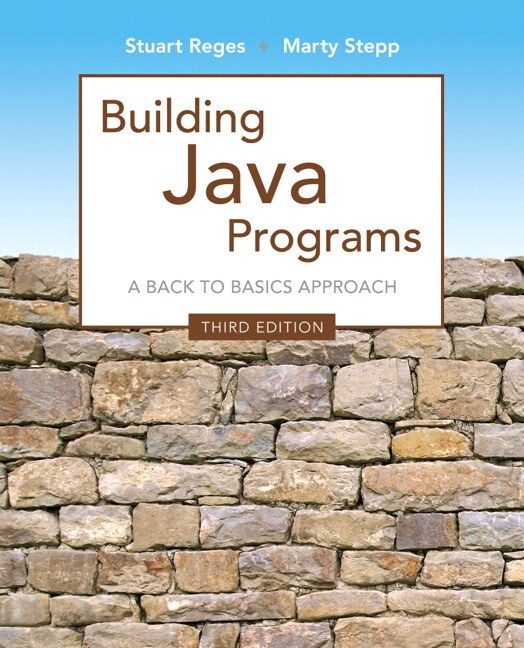Jan 18, 2016 Some of the.java source file names correspond to the excercise name where the solution only requires one class. In this case the main class contains methods to run each exercise. Some of the.java source files correspond to the name of the class suggested by the book where a solution requires more than one class. Edition answers building java programs 3rd edition answers now welcome the most inspiring book today from a very professional writer in the world building java programs' 'Building Java Programs 3rd Edition Answers asprun de March 24th, 2018 - get the reason why this building java programs 3rd edition answers book will probably make you.
- Solutions To Building Java Programs (9780133360905 ...
- Java Programming 3rd Edition Exercise Answers
- Building Java Programs 3rd Edition Exercise Answers Key
- Cached
For courses in Java Programming. This package includes MyProgrammingLab ™. Layered, Back-to-Basics Approach to Java Programming. Newly revised and updated, this Fourth Edition of Building Java Programs: A Back to Basics Approach uses a layered strategy to introduce Java programming and overcome the high failure rates that are common in introductory computer science. Comments do not cause any action to be performed when the program executes. They're used to document programs and improve their readability. Java is case sensitive, so these variables are distinct. The remainder operator can also be used with noninteger operands in Java.
Write a method called swapPairs that switches the order of values inan ArrayList of String s in a pairwise fashion. Your method shouldswitch the order of the first two values, then switch the order ofthe next two, then the next two, and so on. If the number of valuesin the list is odd, the method should not move the final element. Forexample, if the list initially stores (“to”, “be”, “or”,“not”, “to”, “be”, “hamlet”), your method shouldchange the list’s contents to (“be”, “to”, “not”, “or”,“be”, “to”, “hamlet”).
Solutions To Building Java Programs (9780133360905 ...

Supplements, 5th edition
The following supplements are available to all instructors and students using the textbook. Some of our supplements are password-protected (marked with this padlock icon: ), such as solutions to all end-of-chapter exercises and programming problems, sample homework assignments and their solutions, sample exams, and others. If you are an instructor using BJP in your course and need the password to these protected supplements, please email the authors with a link to evidence that you are an instructor, and we will be happy to provide it to you. The password is never given out to students.
- Video Notes (watch the authors walk through tutorials from each chapter; requires an access code provided with new copies of the textbook)
- YouTube Videos (YouTube version of our videos, provided since Adobe Flash is being retired on web browsers)
- MyProgrammingLab (online practice problems; requires access code to use)
- Practice-It! (web system for practicing solving Java programming problems online; free for all to use; not officially associated with textbook)
- CodeStepByStep (sister site of Practice-It!; access to many free online coding exercises)
- PowerPoint slides for 5th edition, by chapter (updated July 3, 2019):
- Chapter 18: Advanced Data Structures (Hashing, Priority Queues/Heaps)
- ZIP archive of all of the above slides (14 MB)
- Code files that appear in each chapter of 5ed; last updated July 3, 2019
- DrawingPanel.java (support class for drawing graphics; last updated July 3, 2019)
- ZIP archive of all code files; last updated July 3, 2019
- 'Section' handouts and solutions
- (used for TA discussion sections and/or closed lab sessions)
- Lab Problem Sets for weekly closed CS1 lab sessions (updated July 3, 2019)
- Chapter 1: Java Basics Static Methods
- Chapter 2: Expressions and Variables,
forLoops - Chapter 3: Parameters, Return, Strings, Scanner
- Supplement 3G: Graphics
- Chapter 4:
if/else, Cumulative Algorithms - Chapter 5:
whileLoops, Random Numbers,booleanLogic - Chapter 6: File Processing
- Chapter 7: Arrays
- Chapter 8: Classes and Objects
- Chapter 9: Inheritance, Critters
- Chapter 10: ArrayLists
- Chapter 11: Collections
- Chapter 12: Recursion
- Chapter 13: Searching and Sorting
- Chapter 14: Stacks and Queues
- Chapter 15: Implementing a Collection Class (ArrayIntList)
- Chapter 16: Linked Lists
- Chapter 17: Binary Trees
- Chapter 18: Advanced Data Structures (hashing, heaps)
- Chapter 19: Functional Programming
- CS1 Exam Prep: Midterm, Final Exam
This document contains complete solutions to all Self-Check problems found at the end of chapters of our textbook. Instructors, please note that students have access to all Self-Check solutions, so Self-Check problems should probably not be assigned as graded homework. (Solutions to Exercises and Programming Projects are not posted publicly for students to see, so those can be assigned as homework problems if so desired.)
- Test Bank of past exams and exam question ideas
Java Programming 3rd Edition Exercise Answers
Other Resources
Building Java Programs 3rd Edition Exercise Answers Key
- University of Washington, CSE 142 course web site (CS1)
- University of Washington, CSE 143 course web site (CS2)
(web sites for our CS1 and CS2 courses at UW that use the Building Java Programs textbook)